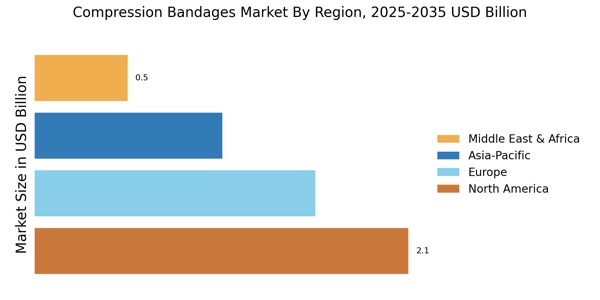Rising Awareness of Wound Care
There is an increasing awareness of wound care practices among healthcare professionals and patients, which is positively influencing the Compression Bandages Market. Education on proper wound management techniques has led to a greater understanding of the benefits of compression therapy in promoting healing and preventing complications. Data suggests that effective wound care can significantly reduce healing time and improve patient outcomes. As healthcare systems emphasize quality care, the demand for compression bandages, which are essential in managing various types of wounds, is expected to rise. This heightened awareness is prompting healthcare providers to recommend compression bandages more frequently, thereby expanding their usage in clinical settings and at home.
Growing Incidence of Sports Injuries
The rising incidence of sports injuries is a notable driver for the Compression Bandages Market. As participation in sports and physical activities increases, the likelihood of injuries such as sprains, strains, and fractures also escalates. According to recent data, sports injuries account for a significant percentage of emergency room visits, highlighting the need for effective treatment solutions. Compression bandages play a crucial role in the management of these injuries by providing support and reducing swelling. This trend is likely to propel the demand for compression bandages, as athletes and active individuals seek reliable products to aid in recovery and enhance performance. Consequently, manufacturers are focusing on developing innovative compression bandages that cater to the specific needs of athletes, further driving market growth.
Aging Population and Chronic Conditions
The aging population and the prevalence of chronic conditions are significant factors driving the Compression Bandages Market. As individuals age, they often experience a higher incidence of conditions such as venous insufficiency, diabetes, and arthritis, which necessitate the use of compression therapy. Statistics reveal that the elderly population is expected to grow substantially in the coming years, leading to an increased demand for medical supplies, including compression bandages. This demographic shift is prompting healthcare providers to focus on preventive care and management strategies that incorporate compression therapy, thereby enhancing the market's potential. The need for effective solutions to manage chronic conditions is likely to sustain the demand for compression bandages.
Technological Advancements in Product Development
Technological advancements in product development are transforming the Compression Bandages Market. Innovations such as the integration of smart textiles and advanced materials are enhancing the functionality and effectiveness of compression bandages. For instance, some products now feature moisture-wicking properties and antimicrobial treatments, which improve comfort and reduce the risk of infection. Market data indicates that the introduction of these advanced products is attracting a broader consumer base, including those seeking high-performance solutions for injury management. As manufacturers continue to invest in research and development, the availability of technologically advanced compression bandages is likely to increase, further stimulating market growth.
Expansion of Retail and Online Distribution Channels
The expansion of retail and online distribution channels is a crucial driver for the Compression Bandages Market. As consumers increasingly turn to e-commerce for their healthcare needs, the accessibility of compression bandages has improved significantly. Data indicates that online sales of medical supplies have surged, with many consumers preferring the convenience of purchasing products from home. Retailers are also expanding their offerings to include a wider range of compression bandages, catering to diverse consumer preferences. This trend is likely to enhance market penetration and increase sales volume, as more individuals become aware of the benefits of compression therapy. The growth of distribution channels is expected to play a pivotal role in shaping the future landscape of the compression bandages market.


















Leave a Comment